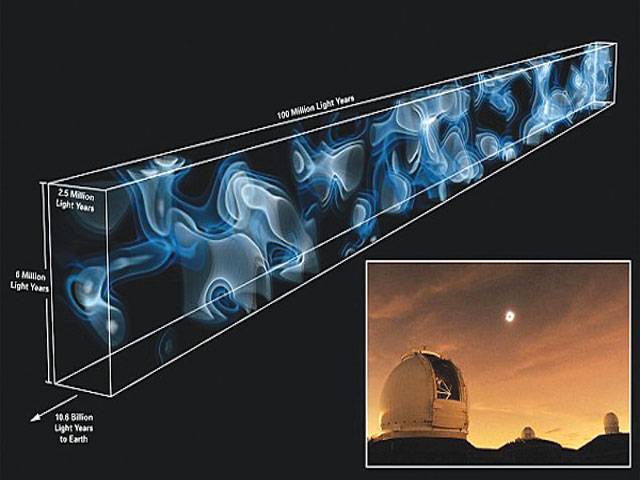DM CALIFORNIA - Scientists have created a map of the matter in a segment of the universe, which could reveal how the universe came to be.
The incredible ‘pencil beam’ shows the distribution of the cosmic web across a slice of the sky 10.8 billion years ago. Amazingly it accurately predicts where galaxies will appear - and it could help us understand the evolution of the universe, both into the past and the future.
The research was led by Dr Khee-Gan Lee from the Max Planck Institute of Astronomy in Germany. The three-dimensional map shows the ‘adolescent’ universe as it appeared just three billion years after the Big Bang, which occurred about 13.8 billion years ago.
Using a technique similar to an X-ray computer-tomographic (CT) scan used in medicine, the researchers revealed the dense grid of light from background galaxies. The snippet we see here, though, merely predicts where galaxies will appear based on the density of matter and dark matter in certain areas of the universe - the cosmic web - before galaxies formed.
This is made possible as the light from background galaxies passes through hydrogen gas in the universe. In the map the lighter areas show regions of high-density matter where galaxies would ultimately form, while the black regions show ‘voids’ - the space between galaxies. The astronomers used the Keck I telescope at the W. M. Keck Observatory on Mauna Kea, Hawaii to make the map.
In total they managed to observe the segment of space for four hours, although they had been hoping for longer. However that was enough time to create the three-dimensional section of the universe almost 11 billion light-years away. Speaking to MailOnline,
Dr Xavier Prochaska from the University of California Santa Cruz, who was part of the research team, commented on the significance of the 3D map.
‘At the top level it’s a test of our current theory of cosmology,’ he tells MailOnline. ‘It shows us how the universe forms over cosmic time.’ He described the segment as a ‘pinhole through the universe’ or a ‘pencil beam’ showing its grand history. Lead researcher Dr Lee, meanwhile, adds: ‘This is the first time people have used light to map the universe in such a way in 3D.
‘They have used it in the past, but previously it has always been to study the cosmic web in 1D, directionally along the line of sight.’ This is also the first time the cosmic web has been mapped at such a vast distance. Since observing to such immense distances is also looking back in time, the map reveals the early stages of cosmic structure formation when the universe was only a quarter of its current age.
This was during an era when the galaxies were undergoing a major ‘growth spurt’. The map provides a tantalising glimpse of giant structures extending across millions of light-years, and paves the way for more extensive studies that should reveal not only the structure of the cosmic web, but also details of how it works. This includes the ways that gas moved around the web into galaxies, providing the raw material for the growth of galaxies through the formation of stars and planets.
Sunday, May 19, 2024
CT scan of universe

Sports & Genocide
May 18, 2024
Healing AJK
May 18, 2024
A New World Order
May 18, 2024
Tobacco Toll
May 17, 2024
Rushed Reforms
May 17, 2024
Continuing Narrative of Nakba
May 18, 2024
Teacher Struggles
May 18, 2024
No Filers out of Reach
May 18, 2024
Hoax of Inflation Coming Down
May 17, 2024
Rising Inflation
May 17, 2024
ePaper - Nawaiwaqt
Advertisement
Nawaiwaqt Group | Copyright © 2024





